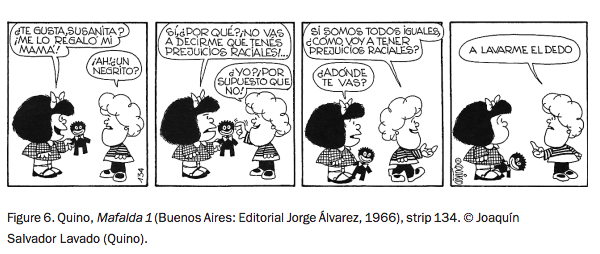Ever since I was little, my mom has been sharing Mafalda comics with me! We have entire books in our house full of Mafalda comics. This weeks’ readings on Mafalda and other Argentine comics are especially interesting to me because I have never realized how significant comics are to Argentinian society as a whole – to me they were always random and cute things my mom would share with me for fun. In hindisight though, I feel like I should have realized how important these comics are seeing as how cynical humour and sarcasm is very prevalent in Argentinian culture.
Looking at the comics, I love how Mafalda is both cute but also very straightforward and even cynical. Whether it is her responses to particular situations or the reactions of those around her, the comics reveal serious issues in a comedic way. A great example of this is this segment on racism: 
As seen above, I really enjoy how she is clearly smarter than most people she interacts with, especially when it comes to issues of equality. More importantly though, Mafalda brings sheer human ignorance and stupidity to light just by simply existing and being an unprejudiced human being. I find that this is how many forms of discrimination are often revenaled in real life – when regular unproblematic situations suddenly become an issue due to someone’s prejudices. Despite being a child, Mafalda exemplifies simple, rational, and unprejudiced ideas. As Cosse’s article suggests, these comics in the setting of Argentina’s history with fascist dictatorships, was demonstrative of Argentinian’s more liberal and progressive citizens. I would even argue that Mafalda still represents this in the context of Argentina’s current political state under Alberto Fernández’s central-left Peronist government.
A thing that I enjoyed reading from Cosse’s article is that Mafalda helped to demonstrate how heterogenous Argentinia’s middle-class was at the time due to cultural and ideological differences within the socioeconomic stratum. The majority of the comics show Mafalda being in conflict with the people she interacts with, although most of them live in a state of apparent understanding or peace. This comic demonstrates this for me:

Although there are certainly exceptions to this, I feel like the way Mafalda interacts with other people is a true reflection of low to upper-middle class Argentinian culture in its broadest sense. Despite often being in conflict with each other and treating each other somewhat rudely (e.g. using sarcasm and insults casually, complaining CONSTANTLY), they still coexist and work together against the systems that oppress them.
Discussion question: To what extent can we trust popular art to accurately represent the cultures it originates from? Does it have a responsibility to do so? If so, should it even have that responsibility?

Hi Magalee!
I love that you had a pre-existing love for these comics, as I think it is a perfect example of how popular culture can become so normal to us, so much a part of our everyday life, that we don’t even recognize it as being significant! What an important understanding in the study of pop culture!
I also think that it gives you a fairly unique (in terms of this class) view of these comics, and I thoroughly enjoyed reading your interpretations. As for your discussion question, I think popular art does have somewhat of a responsibility to accurately represent it’s originating culture(s). However, I think that when it comes to any kind of art, the words ‘accurate representation’ have meaning that is very widespread and up for interpretation. It is up to the artist to decide what is the way that they want to represent their culture(s), and make sure that it is true to themselves and their view of it.